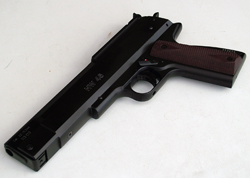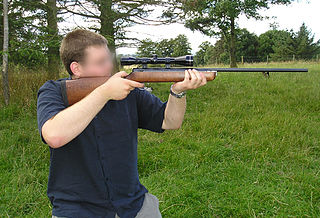
The Lee–Enfield is a bolt-action, magazine-fed repeating rifle that served as the main firearm of the military forces of the British Empire and Commonwealth during the first half of the 20th century, and was the standard service rifle of the British Armed Forces from its official adoption in 1895 until 1957.

An air gun or airgun is a gun that uses energy from compressed air or other gases that are mechanically pressurized and then released to propel and accelerate projectiles, similar to the principle of the primitive blowgun. This is in contrast to a firearm, which shoots projectiles using energy generated via exothermic combustion (detonation) of chemical propellants, most often black powder or smokeless powder.
The Accuracy International Arctic Warfare rifle is a bolt-action sniper rifle designed and manufactured by the British company Accuracy International. It has proved popular as a civilian, police, and military rifle since its introduction in the 1980s. The rifles have features that improve performance in extremely cold conditions without impairing operation in less extreme conditions.

A shotgun slug is a heavy projectile made of lead, copper, or other material and fired from a shotgun. Slugs are designed for hunting large game, and other uses, particularly in areas near human population where their short range and slow speed helps increase safety margin. The first effective modern shotgun slug was introduced by Wilhelm Brenneke in 1898, and his design remains in use today. Most shotgun slugs are designed to be fired through a cylinder bore, improved cylinder choke, rifled choke tubes, or fully rifled bores. Slugs differ from round ball lead projectiles in that they are stabilized in some manner.

The Weihrauch HW 45 is an air pistol manufactured by Weihrauch & Weihrauch in Germany and originally developed as a collaboration between American importer Robert Beeman and Weihrauch. It is more commonly known in North America as the Beeman P-1 after the US importers and is a large, full power air pistol with an ambidextrous grip, available in three different calibres: .177, .20 and .22. The HW 45 is suitable for informal target shooting and plinking.

Gamo Outdoor S.L.U, or simply Gamo, is a Spanish airgun manufacturer based in Barcelona, Spain, and is the largest producer of airguns in Europe and the largest producer of airgun pellets in the world. The company was founded in 1959, as El Gamo, and airgun production first started in 1961. Today Gamo products include air rifles, air pistols, ammunition and optics. They produce primarily airguns intended for mass market.
The SG 550 is an assault rifle manufactured by SIG Sauer AG in Switzerland. "SG" is an abbreviation for Sturmgewehr. The rifle is based on the earlier 5.56×45mm NATO SIG SG 540.

Field target is an outdoor airgun field shooting sport. Competitions are usually fired at self indicating steel targets placed between 9 and 50 m. There are two classes; Piston for spring-piston air guns, and PCP for pre-charged pneumatic air guns. In sanctioned competitions, the same competition rule set is used around most of the world. A small match can consist of 40 to 60 rounds, while the world championship consists of 150 rounds. It is common to use scope sights with high magnification and a short depth of field such that an adjustable parallax knob can be used to precisely determine the target distance. The target kill zones have three standardised sizes, which are 15 mm, 25 mm or 40 mm.

The BSA Supersport is an air rifle produced by BSA Guns (UK) Limited a subsidiary of Spanish manufacturer Gamo and was first introduced in 1986. It is essentially the same rifle as the Lightning, the only difference being that the Lightning has the BSA Volumetric Silencer fitted. It is made in three calibres, 0.177 in (4.5 mm), 0.22 in (5.6 mm) and 0.25 in (6.4 mm).
The BSA Scorpion Air Pistol was an air pistol made by the Birmingham Small Arms Company and first produced in 1973. It was a large, heavy, spring powered, single-shot weapon available in .177 (4.5 mm) and .22 (5.5 mm) calibers and was BSA's first air pistol. At 5.5 ft•lbf, it was close to the UK legal power limit for an air pistol.

The FR F1 is a French sniper rifle manufactured by the Manufacture d'armes de Saint-Étienne (MAS); one of several government-owned arms factories in France. The FR F1 was France's first purpose-built precision rifle for sharpshooters. Introduced in 1966, the rifle was in use with the French Armed Forces until 1989 when it was replaced by the FR F2.
The BSA Ultra is a popular, precharged pneumatic air rifle manufactured by a subsidiary of Spanish manufacturer Gamo, BSA Guns (UK) Limited and sold worldwide. Widely used for both sport and hunting it has proven itself to be both accurate and reliable. It is an unregulated, pneumatic powered air gun available in both .177 and .22 calibres and with a choice of either single shot or multi-shot. It is one of the cheapest PCP air rifles available in the market. It was designed by BSA designer John Bowkett.
The Walther LGR air rifle was developed by the German arms manufacturer Carl Walther GmbH Sportwaffen as a high end match rifle for 10 metre air rifle competition shooting. The LGR was the first match air rifle that employed the then futuristic single-stroke pneumatic method as power source. This use of pre compressed air introduced the advantages of recoilless and vibration free shooting in combination with a well-made air rifle into the sport. It took other manufacturers a decade before they also introduced single-stroke pneumatic match air rifles.
The PSL is a Romanian designated marksman rifle. It is also called PSL-54C, Romak III, FPK and SSG-97. Though similar in appearance, mission and specifications to the SVD Dragunov, the PSL rifle is mechanically completely different as it is based on the RPK light machinegun, with its internals simply being scaled up to accommodate the more powerful 7.62×54mmR cartridge.
The BSA Mercury was a break barrel, spring powered, Air Rifle first produced in 1972 by the Birmingham Small Arms Company and then Gamo (UK) Limited. It was manufactured in .177 (4.5 mm) .22 (5.5 mm) and .25 (6.35 mm), the latter named the "635 Magnum". The Mercury was marketed between the BSA Meteor and AirSporter models and was a light, easy to use rifle, giving a "just under legal limit UK power" of 11.5 ft•lbf of energy.
The BSA Buccaneer was a break barrel spring powered air rifle first produced in 1977 by the Birmingham Small Arms Company, manufactured in both .177 (4.5 mm) and .22 (5.5 mm) calibers and marketed as an introduction air rifle for younger shooters with a muzzle energy of 5.5 ft•lbf. The rifle had a safety catch, which was disengaged by operation of a lever next to the shooter's thumb.
The Weihrauch HW 35 is a break barrel, spring-powered, air rifle first produced in 1951 by Weihrauch & Weihrauch located in Mellrichstadt, Bavaria. Available in 4,5 mm and 5,5 mm calibers, with standard and carbine (K) length barrels, it has been in continuous production since its launch, even though the Weihrauch HW 80 superseded it in the late 1990s.
The BSA CF2 is a rifle manufactured by the Birmingham Small Arms Company (BSA).
The Remington Model 572 Fieldmaster is a slide action, manually-operated .22 caliber (rimfire) repeating rifle manufactured by Remington Arms Company. First introduced to the commercial market in 1956, the 572 Fieldmaster rifle incorporates a tubular magazine capable of feeding .22 Short, .22 Long, or .22 Long Rifle rimfire cartridges, a cross-bolt safety, and an aluminum receiver grooved for scope mounts. The original Fieldmaster used a 22.75-inch barrel. The Model 572 uses many of the design features first introduced on the Remington Model 870 shotgun, and replaced the Model 121 Fieldmaster as the company's slide-action rimfire repeater. The 572 was discontinued in 2020 following the bankruptcy of the parent company.
The BSA AirSporter was an underlever spring powered Air Rifle first produced in 1948, by the Birmingham Small Arms Company and remained more or less unchanged until 1962 when the Mk2 was produced. The Mk1 had a one-piece barrel and receiver assembly with a leather piston washer, while all other marks had a screw-in barrel with most having an Oring after the mk 2 piston and steel tap seal, giving a "legal UK power" of 10 ft•lbf of energy.








